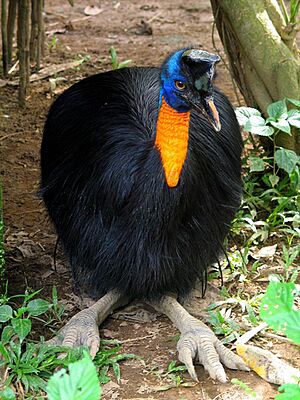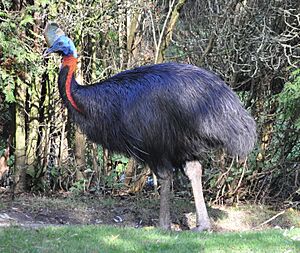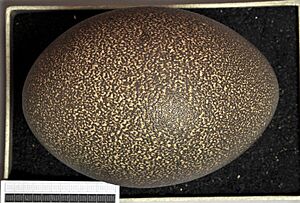Northern cassowary facts for kids
The northern cassowary (Casuarius unappendiculatus), also called the one-wattled cassowary, is a big, strong bird that cannot fly. It lives in northern New Guinea. This bird is one of three types of cassowary still alive today. The other two are the dwarf cassowary and the southern cassowary. Cassowaries are part of a group of birds called Paleognathae, which includes ostriches and emus.
Quick facts for kids Northern cassowary |
|
|---|---|
 |
|
| At Bali Bird Park | |
| Conservation status | |
| Scientific classification | |
| Genus: |
Casuarius
|
| Species: |
unappendiculatus
|
 |
|
| Distribution of the northern cassowary | |
Contents
Discovering the Northern Cassowary
A scientist named Edward Blyth first officially identified the northern cassowary. He did this in 1860, after seeing a bird in an aviary (a large bird enclosure) in Calcutta, India. It was the last type of cassowary to be discovered.
The name Casuarius comes from the Malay word kesuari, which means "cassowary". The second part of its scientific name, unappendiculatus, means "single wattle". This refers to the single fleshy growth on its neck.
What Does a Northern Cassowary Look Like?
The northern cassowary has stiff, black feathers. Its face is blue, and it has a hard, helmet-like growth called a casque on top of its head. Its neck is bright red or yellow, and it has a single fleshy growth called a wattle.
These birds have huge, powerful feet with a long, sharp, dagger-like claw on their inner toe. Both male and female northern cassowaries look similar. However, the male is smaller, weighing about 30 to 37 kilograms (66 to 82 pounds). The female is larger, weighing around 58 kilograms (128 pounds).
This makes the female northern cassowary the fourth heaviest living bird. Only the common ostrich, Somali ostrich, and southern cassowary are heavier. These birds can be about 149 centimeters (59 inches) long. They stand tall, reaching about 1.5 to 1.8 meters (5 to 6 feet) in height.
Compared to the southern cassowary, the northern cassowary has a slightly shorter bill. Its bill is about 12 to 13.7 centimeters (4.7 to 5.4 inches) long. However, its leg bones (tarsus) are a bit longer, measuring 28 to 33.2 centimeters (11 to 13.1 inches).
How Northern Cassowaries are Related to Other Birds
Northern cassowaries belong to a bird family called Casuariidae. This family includes only four types of birds that are still alive today. Three of these are the different kinds of cassowaries. The fourth is the emu.
All these birds are large and cannot fly. Northern cassowaries and emus share some similar features. For example, both have a blue patch of color on their face or neck. However, these patches are used for different things. The emu's blue patch is lighter and helps it blend in with its surroundings. The northern cassowary's blue patch is brighter and helps it attract mates.
Some scientists have suggested a different way to group these birds. In 2014, a study looked at their DNA. It proposed that cassowaries should be in their own group called Casuariformes. This group would only include cassowaries in the Casuariidae family. Emus would then be placed in their own separate family, Dromaiidae.
Where Northern Cassowaries Live
The northern cassowary lives only in certain areas. It is found in the coastal swamp and lowland rainforests of northern New Guinea. It also lives on the islands of Yapen, Batanta, and Salawati. These birds usually prefer to live in areas below 490 meters (1,600 feet) in elevation.
Here is an idea of their numbers:
| Location | Population Status | Trend |
|---|---|---|
| Northern Papua New Guinea | Numbers are not fully known | Going down |
| Yapen | Numbers are not fully known | Going down |
| Batanta | Numbers are not fully known | Going down |
| Salawati | Numbers are not fully known | Going down |
| Waigeo | Numbers are not fully known | Going down |
| Total | Estimated 2,500 to 10,000 birds | Going down |
Northern Cassowary Behaviour
Like other cassowaries, the northern cassowary is a shy bird that usually lives alone. Their main diet includes berries, fruits, and small animals. They eat things like mice, rats, frogs, snakes, lizards, smaller birds, and various small insects and snails. They will also eat dead animals if they find them.
Young cassowaries have been seen eating the droppings of the males raising them. Adult birds also eat their own droppings because they often contain undigested fruits. Northern cassowaries make grunting and hissing sounds, similar to other cassowaries.
Northern Cassowary Reproduction
During the breeding season, the female northern cassowary may mate with several males. She lays three to five green eggs in a nest that the male has carefully hidden. After laying the eggs, the female leaves the nest and eggs. She then goes to find another mate.
The male cassowary is responsible for everything else. He sits on the eggs to keep them warm until they hatch. He then raises the chicks by himself for about nine months.
Protecting the Northern Cassowary
The northern cassowary faces threats from losing its home and being hunted too much in some areas. However, as of 2017, it is listed as "Least concern" on the IUCN Red List of Threatened Species. This is because recent estimates suggest there are more of these birds than previously thought.
Despite this, it is considered the most threatened of the three types of cassowaries as of 2022. Hunting is still the biggest danger. Local people use the bones and eggs of the birds. They also take young chicks to raise them for meat. As logging opens up more parts of the forest, hunting could become an even bigger problem. The area where they live covers about 186,000 square kilometers (71,800 square miles). An estimate from 2000 suggested there were about 9,300 northern cassowaries.




